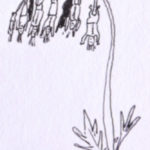
The Traveling Plant: Preparatory Logbook
People were asked, in a caring hosting tradition, to tell the plant what it could expect to experience and to discover along its journey, what and whom (humans and other than humans) it may encounter. Choose a contributor in the menu (v) or browse by following the arrows < >
Pierre Cox
Manypeeplia Upsidownia
Paris, France
Astrophysicist (Institut d’Astrophysique de Paris)
To Mr. Thomas Bridges
Estancia Haberton
Ushuaia, Tierra del Fuego
August 8, 1880
Dear Mister Bridges,
In London, I found a new plant Whose flower was a pure delight; “Manypeeplia Upsidownia” Is the name I gave to this plant.
Every day, before sunrise, the flower starts to sing in a perfect canon along the music of “Frère Jacques”, namely:

Morning bells are ringing! Morning bells are ringing! Ding, dong, dong. Ding, dong, dong.

I here send you seeds & a living plant in the hope that they arrive safely & well & that you can grow the “Manypeeplia Updsidownia” successfully in Patagonia. In doing so you do honor to the Science of your Country, Promote in Some Degree the Commerce & aid the Population. It is with uttermost curiosity that I await you report & hear from you if the flower also sings its song in Waghan or any other native language of Tierra del Fuego.
Most sincerely yours,
Edward Lear
Partners
The Traveling Plant is a collective project created in 2020 by Annick Bureaud, Tatiana Kourochkina, Marta de Menezes, Claudia Schnugg and Robertina Šebjanič, and further developed with the following seed organisations Leonardo/Olats (Paris), Quo Artis (Barcelona and Treviso), Cultivamos Cultura (Lisbon), Sektor Institute (Ljubljana) and the initial support of the Daniel and Nina Carasso Foundation.

Leonardo/Olats
Observatoire Leonardo des Arts et des Techno-Sciences
À propos / About



Pour toute (re)publication, merci de contacter / For any (re)publication, please contact Annick Bureaud: info@olats.org
Pour toute question concernant le site, merci de contacter / For any issue about the website, please contact: webmaster@olats.org
Design Thierry Fournier
© Association Leonardo 1997-2022